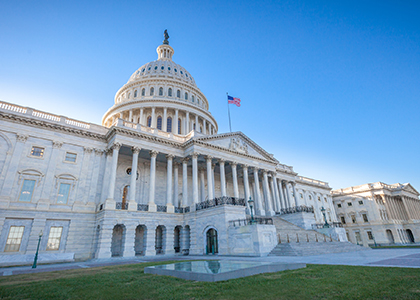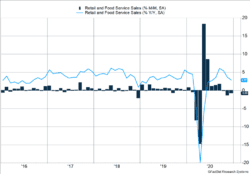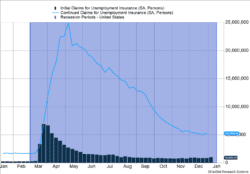The signs of an economic slowdown continue. Initial jobless claims, which are released weekly, spiked to 965,000 last week. Claims increased by 181,000 and marked the highest weekly total since mid-August. Continuing claims increased 199,000, indicating those losing work are not finding new employment right away. Based on other data points, many of those filing for unemployment expect to be rehired when newly imposed restrictions are reduced.
Key Points for the Week
- Initial jobless claims spiked to a five-month high in response to COVID-related restrictions.
- Retail sales dropped 0.7% for their third straight monthly decline.
- President-elect Joe Biden proposed a $1.9 trillion stimulus package that includes more direct payments and aid to state and local governments.
The same trend toward lower activity was evident in last month’s retail sales data. Retail sales dropped for the third month in a row. December’s 0.7% decline would have been worse without a 6.6% increase in gasoline sales (Figure 1). An increase in gas prices pushed sales higher. Internet retailers and restaurants generated lower sales compared to the previous month.
Large-cap stocks gave back some of their earlier gains. The S&P 500 dipped 1.5%. The MSCI ACWI sagged 1.2%. The Bloomberg BarCap US Aggregate Bond Index gained 0.2% as interest rates dropped in response to the weak economic data.
President-elect Biden unveiled a plan for $1.9 trillion of additional stimulus that will extend some benefits set to expire in March. The proposal includes another round of payments to individuals and support for unemployed workers, state and local governments, and COVID-related health plans. Some elements are likely to be approved and others face a more challenging process as some Republican votes will be required to pass it. Our focus remains on the pace of vaccine distribution as the key source of long-term economic support.
Figure 1
Still Stuck in a Rut
Getting stuck in a rut has been extra challenging during our COVID lives. Always a challenge for humans, falling into poor habits is even easier during a pandemic. The variety of things we can do has been reduced, and the steady discipline of social distancing can lead to the formation of empty habits and missed opportunities for growth.
December’s retail sales data and the most recent jobless claims report show the economy faces similar challenges and remains stuck in a rut. A deeper look at Figure 1 reveals multiple signs the economy can’t get to the next level.
- Retail sales have declined for three consecutive months (dark blue bars). During the strong employment environment prior to COVID-19, there were only incidental declines.
- The bright blue line, which shows growth relative to the previous year, is trending lower, reflecting the declining growth trend in recent months.
- The level of the bright blue line corresponds with levels seen prior to COVID. This means we are no longer making up for lost consumption earlier in the year.
Figure 2
Figure 2 shows a similar story. Initial unemployment claims (dark blue bars) remain far above COVID-19 levels. In recent weeks, the steady decline has reversed, with small increases as common as improvements. The number of people receiving unemployment claims for at least two consecutive weeks has also climbed.
So, what gets us out of the rut? The recently approved stimulus package will help. It is broadly true that if you give people an unexpected bonus, some of the money will be spent. Yet, economic data show much of it is saved and does not make it back into the U.S. economy. But the reliance on stimulus packages reflects an economic mindset that emphasizes government aid as the key tool for reviving an economy. The current slowdown differs from those in the past as many people are anxious to spend but the risks of doing so are too high.
Which leads us back to the vaccines. For all the discussion on how big the next set of checks ought to be, the most significant economic stimulus will be accomplished with a needle and a highly effective vaccine. Every person who receives a vaccine has more choices available to them and more activities they can pursue. Those choices represent their own little stimulus package. Thank you to all the health care workers who are making the distribution of vaccines possible.
—
This newsletter was written and produced by CWM, LLC. Content in this material is for general information only and not intended to provide specific advice or recommendations for any individual. All performance referenced is historical and is no guarantee of future results. All indices are unmanaged and may not be invested into directly. The views stated in this letter are not necessarily the opinion of any other named entity and should not be construed directly or indirectly as an offer to buy or sell any securities mentioned herein. Due to volatility within the markets mentioned, opinions are subject to change without notice. Information is based on sources believed to be reliable; however, their accuracy or completeness cannot be guaranteed. Past performance does not guarantee future results.
S&P 500 INDEX
The Standard & Poor’s 500 Index is a capitalization-weighted index of 500 stocks designed to measure performance of the broad domestic economy through changes in the aggregate market value of 500 stocks representing all major industries.
MSCI ACWI INDEX
The MSCI ACWI captures large- and mid-cap representation across 23 developed markets (DM) and 23 emerging markets (EM) countries*. With 2,480 constituents, the index covers approximately 85% of the global investable equity opportunity set.
Bloomberg U.S. Aggregate Bond Index
The Bloomberg U.S. Aggregate Bond Index is an index of the U.S. investment-grade fixed-rate bond market, including both government and corporate bonds
https://www.dol.gov/ui/data.pdf
https://www.census.gov/retail/marts/www/marts_current.pdf
Compliance Case: 00928221




